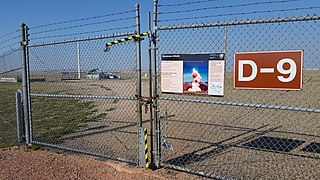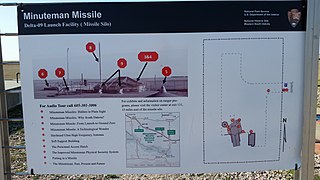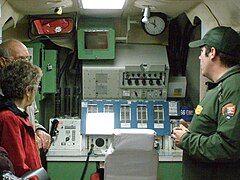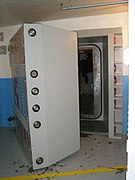
The LGM-30 Minuteman is an American land-based intercontinental ballistic missile (ICBM) in service with the Air Force Global Strike Command. As of 2024, the LGM-30G is the only land-based ICBM in service in the United States and represents the land leg of the U.S. nuclear triad, along with the Trident II submarine-launched ballistic missile (SLBM) and nuclear weapons carried by long-range strategic bombers.

Vandenberg Space Force Base, previously Vandenberg Air Force Base, is a United States Space Force Base in Santa Barbara County, California. Established in 1941, Vandenberg Space Force Base is a space launch base, launching spacecraft from the Western Range, and also performs missile testing. The United States Space Force's Space Launch Delta 30 serves as the host delta for the base. In addition to its military space launch mission, Vandenberg Space Force Base also hosts space launches for civil and commercial space entities, such as NASA and SpaceX.

Malmstrom Air Force Base is a United States Air Force base in Cascade County, Montana, United States, adjacent to the city of Great Falls. It was named in honor of World War II POW Colonel Einar Axel Malmstrom. It is the home of the 341st Missile Wing of the Air Force Global Strike Command (AFGSC). For statistical purposes, the United States Census Bureau has defined Malmstrom Air Force Base as a census-designated place (CDP). It had a population of 3,472 at the 2010 census.

Grand Forks Air Force Base (AFB) (IATA: RDR, ICAO: KRDR, FAA LID: RDR) is a United States Air Force installation in northeastern North Dakota, located north of Emerado and 16 miles (26 km) west of Grand Forks.

Ellsworth Air Force Base (AFB) is a United States Air Force (USAF) base located about 10 miles (16 km) northeast of Rapid City, South Dakota, just north of the town of Box Elder.
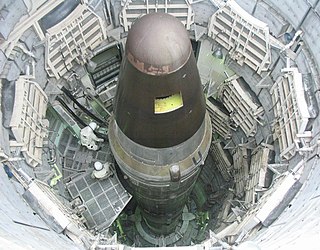
The Titan Missile Museum, also known as Air Force Facility Missile Site 8 or as Titan II ICBM Site 571-7, is a former ICBM site located about 40 km (25 mi) south of Tucson, Arizona in the United States. It was constructed in 1963 and deactivated in 1984. It is now a museum run by the nonprofit Arizona Aerospace Foundation and includes an inert Titan II missile in the silo, as well as the original launch facilities.

A launch control center (LCC), in the United States, is the main control facility for intercontinental ballistic missiles (ICBMs). A launch control center monitors and controls missile launch facilities. From a launch control center, the missile combat crew can monitor the complex, launch the missile, or relax in the living quarters. The LCC is designed to provide maximum protection for the missile combat crew and equipment vital to missile launch. Missile silos are common across the midwestern United States, and over 450 missiles remain in US Air Force (USAF) service.

The South Dakota Air and Space Museum is an aviation museum located in Box Elder, South Dakota, just outside the main gate of Ellsworth AFB. It is dedicated to the history of the United States Air Force, the base and aerospace in South Dakota.

Atomic tourism or nuclear tourism is a recent form of tourism in which visitors learn about the Atomic Age by traveling to significant sites in atomic history such as nuclear test reactors, museums with nuclear weapon artifacts, delivery vehicles, sites where atomic weapons were detonated, and nuclear power plants.

The 44th Missile Wing is an inactive United States Air Force unit. Its last assignment was with Twentieth Air Force, being assigned to Ellsworth AFB, South Dakota. It was inactivated on 4 July 1994.

The Boeing EC-135 is a retired family of command and control aircraft derived from the Boeing C-135 Stratolifter. During the Cold War, the EC-135 was best known for being modified to perform the Looking Glass mission where one EC-135 was always airborne 24 hours a day to serve as flying command post for the Strategic Air Command in the event of nuclear war. Various other EC-135 aircraft sat on airborne and ground alert throughout the Cold War, with the last EC-135C being retired in 1998. The EC-135N variant served as the tracking aircraft for the Apollo program.

The 66th Missile Squadron is an inactive United States Air Force unit. It was last assigned to the 44th Operations Group, stationed at Ellsworth Air Force Base, South Dakota. The 66th was equipped with the LGM-30F Minuteman II Intercontinental ballistic missile, with a mission of nuclear deterrence. With the end of the Cold War, the 66th was inactivated on 1 September 1993. Number of flights 100

The 68th Missile Squadron is an inactive United States Air Force unit. It was last assigned to the 44th Operations Group, stationed at Ellsworth AFB, South Dakota.

The Airborne Launch Control System (ALCS) provides a survivable launch capability for the United States Air Force's LGM-30G Minuteman III intercontinental ballistic missile (ICBM) force. The ALCS is operated by airborne missileers from Air Force Global Strike Command's (AFGSC) 625th Strategic Operations Squadron (STOS) and United States Strategic Command (USSTRATCOM). The system is located on board the United States Navy's E-6B Mercury, which serves as USSTRATCOM's "Looking Glass" Airborne Command Post (ABNCP). The ALCS crew is integrated into the ABNCP battle staff and is on alert around the clock.
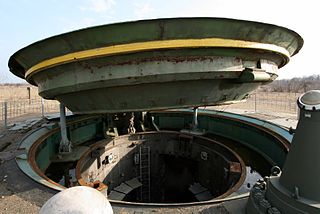
A missile launch facility, also known as an underground missile silo, launch facility (LF), or nuclear silo, is a vertical cylindrical structure constructed underground, for the storage and launching of intercontinental ballistic missiles (ICBMs), intermediate-range ballistic missiles (IRBMs), medium-range ballistic missiles (MRBMs). Similar facilities can be used for anti-ballistic missiles (ABMs).
A missile combat crew (MCC), is a team of highly trained specialists, often called missilemen, or missileers, staffing Intermediate Range and Intercontinental ballistic missile systems. In the United States, personnel, officially coded as Nuclear and Missile Operations Officers, of the United States Air Force, operate underground missile systems at launch control centers located throughout the country. There are also a select few missileers that have the chance to become part of a Missile Combat Crew-Airborne (MCC-A) operating the Airborne Launch Control System which provides a survivable launch capability for the Minuteman ICBM force. Crew size varies among the different missile systems, but the number is always greater than one, to abide by USSTRATCOM's two-man rule for positive control of nuclear weapons.

This is a list of the LGM-30 Minuteman missile, Missile Alert Facilities and Launch Facilities of the 44th Missile Wing, 20th Air Force, assigned to Ellsworth AFB, South Dakota.
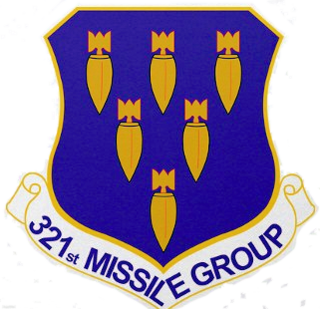
This is a list of the LGM-30 Minuteman missile Missile Alert Facilities and Launch Facilities of the 321st Missile Wing, 20th Air Force, assigned to Grand Forks AFB, North Dakota.

Francis E. Warren Air Force Base, shortened as F.E. Warren AFB is a United States Air Force base (AFB) located approximately 3 miles (4.8 km) west of Cheyenne, Wyoming. It is one of three strategic-missile bases in the U.S. It was named in honor of Francis E. Warren in 1930. Warren AFB is home of the 90th Missile Wing, assigned to the Twentieth Air Force, Air Force Global Strike Command. The 90 MW operates the LGM-30G Minuteman III ICBM. It is also the home of Twentieth Air Force, which commands all U.S. Air Force ICBMs.

Whiteman Air Force Base is a United States Air Force base located just south of Knob Noster, Missouri, United States. The base is the current home of the B-2 Spirit bomber. It is named for 2nd Lt George Whiteman, who was killed during the attack on Pearl Harbor.






